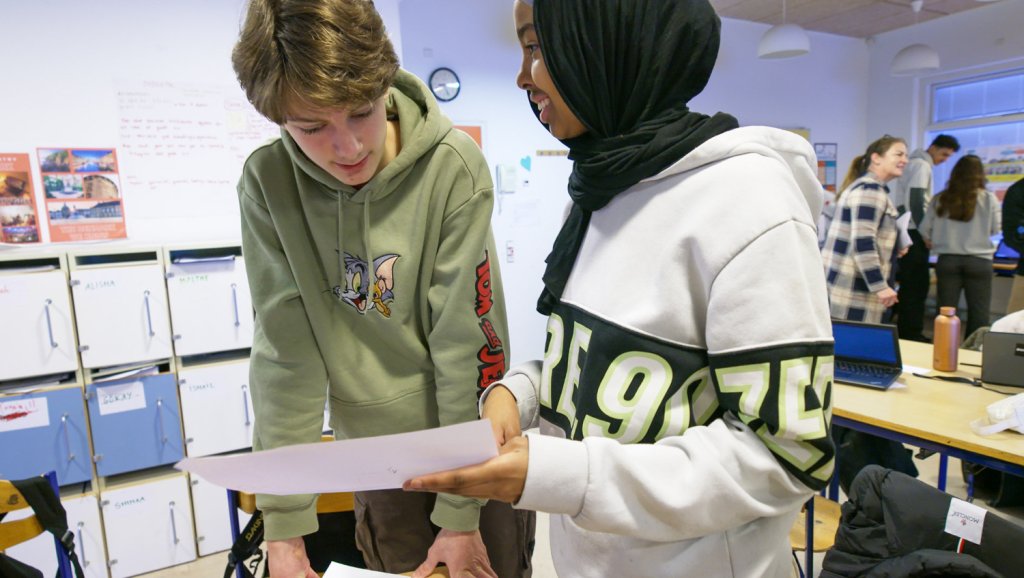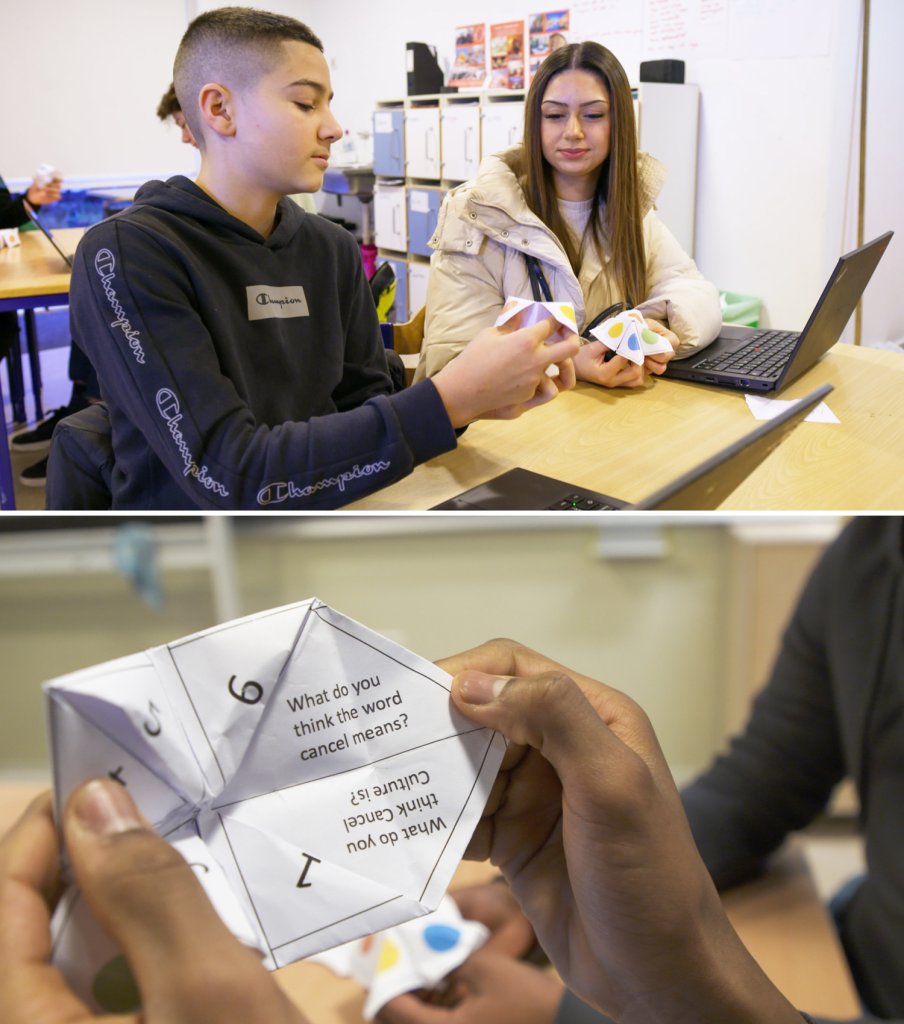5 Playful Strategies That Reduce Language Learning Anxiety
We visited a classroom in Denmark to see how a playful learning philosophy can put students at ease and make language learning joyful and engaging.
Your content has been saved!
Go to My Saved Content.During intimate conversations with just one or two people, Nasteho—whose primary language is Danish—speaks English with the confidence of a native speaker.
But in her ninth-grade English language classroom, where she is surrounded by nearly two dozen of her peers, her composure can evaporate, and typical language learning activities like practicing new vocabulary or answering questions in English can elicit “a lot of stress,” she says.
That’s not unusual. The fear of failure is deep-rooted and powerful in young learners and can prevent them from taking risks and acquiring new skills. This can be especially true in language classes, where research suggests that “teachers often observe learners struggling with physical signs of anxiety such as tense muscles, trembling, and dry throat.” Concerns about making mistakes in front of classmates, especially in middle and high school, can loom large.
Nasteho’s teacher, Fatima Belouahi, is keenly aware of how hard it is for her English language learners to practice their skills while the whole class is “watching and listening.” In Belouahi’s classroom at Lundehusskolen—a bright, newly renovated K–9 school in Copenhagen, Denmark—the focus is on lowering the stakes around language learning.
When Edutopia visited her classroom this winter, Belouahi’s 15- and 16-year-old students sat in small groups casually chatting in English. Students tripped up occasionally—mispronouncing a word or struggling to articulate a complex thought—but they pressed on with a laugh, troubleshooting or correcting themselves.
Instead of trying to convince students that their fears aren’t warranted, Belouahi makes a point of creating a positive, mistake-friendly classroom where students feel comfortable experimenting. One of the ways she does this is by incorporating playful learning strategies. “It doesn’t have to be perfect from the beginning,” Belouahi says. “The goal is for them to use their English language as much as possible and as best as they can. Not perfectly.”
Here are five playful learning strategies from Belouahi’s classroom designed to make the act of learning a new language less daunting, and more joyful, social, and engaging.
Draw It Out
In this exercise, like Pictionary with academic benefits, Belouahi has students draw a representation of a vocabulary term—censorship or free speech, for example—then challenge a partner to identify the words they’ve drawn. It’s a fun, social game that’s backed by research: When students draw information they’re learning, it can increase recall by nearly double.

After organizing students into pairs or small groups, Belouahi gives the class a list of challenging English language vocabulary words and phrases focused on the day’s lesson about social media and cancel culture—a topic her students are familiar with and interested in. To close out the activity, students explain their vocabulary terms to their partners and discuss their illustration. The room fills with laughter as kids work through each other’s sketches, chattering away happily in English.
Inner Circle, Outer Circle
When she wants to introduce new material, emphasize key concepts in a lesson, review before an exam, or have students share their thoughts after independent reading, Belouahi likes to get kids interacting with each other.
“Some days our students only talk to their best friend or the one who sits beside them,” she explains. “But this exercise pushes them to talk to each other, to talk to people at different levels or who have different opinions. That allows for discussions or debates where they have to give their own opinions.”
Start by having students choose a partner and then form two concentric circles—one inner circle and one outer circle. One member of the pair will be on the inner circle, and the other will be on the outer circle, across from each other. Present a question to the class—for example, Belouahi asked students if they thought it was OK to “cancel” or stop supporting someone because of bad behavior they exhibited in the past. Pairs discuss for a set amount of time, then the outer circle of students rotates, providing each student with a new classmate to speak with.
Walk and Talk
Traditionally, students might be given a set of prompts to discuss while seated—and that routinely happens in Belouahi’s classroom. But when she has the time, she likes to incorporate activities that are more active to get students up and moving.
For a walk and talk, students pair up, and Belouahi provides them with open-ended discussion questions. When weather and time permit, pairs walk around a lake that’s near the school, but this activity can be done in a courtyard, school hallways, the gym, or any area where there’s space to move around freely.
Asking questions that are relevant to students’ lives can make conversations more meaningful, while grouping students in pairs allows them the privacy to practice the target language without fear of judgment. “I asked them to discuss if they’ve ever felt threatened at school or how they would handle a situation where they knew a friend was being bullied,” Belouahi says. “And they could have answered while sitting down. But while walking and talking with different classmates, I think the conversations get a bit deeper.”

Fortune Teller
Repurposing a childhood favorite, Belouahi likes to use paper fortune tellers to get kids talking. On the outermost flaps are colors, then numbers. On the innermost flaps, students find a question they’ll discuss in the target language. When we visited the classroom, questions included “What is cancel culture” and “How can someone behave badly online?”
In pairs, one student operates the fortune teller while the other student chooses a color and spells it aloud (“Green, G-R-E-E-N”), then a number (“Four, F-O-U-R”). They’ll choose one more number, which determines the flap to lift and reveals the question the pair will discuss. (For free customizable templates, search online with the keywords “editable fortune teller template.”)
Role-Play as Influencers
Belouahi’s lesson about social media and cancel culture provided a perfect opportunity for students to role-play as influencers, creating fake TikTok videos based on prompts she provided and allowing them to practice their language skills.
In small groups, students received a piece of paper detailing specific scenarios that they’d be acting out. One group was instructed to create a video featuring the fictional Marie D., a beauty influencer who reviewed a new moisturizer and wanted her followers to buy it. Each student played several roles within the group—helping to write the script, operating the phone camera to record, using arts and crafts materials to make props, and directing the student who would play the influencer. At the end of class, students submitted their videos to Belouahi to view.
The exercise gets students to grapple with vocabulary and sentence structures in novel and challenging ways. Because only Belouahi and the small groups themselves view the final videos, students are more likely to take risks and feel less self-conscious as they bravely explore learning and speaking English.
